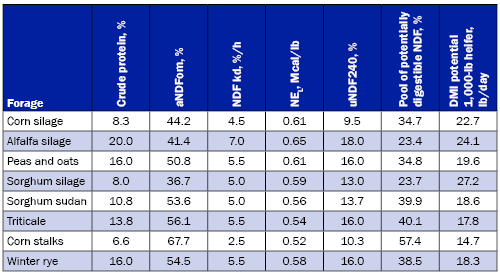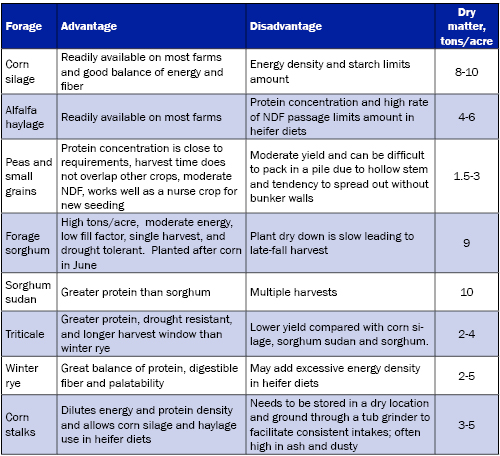
Balancing nutrition and agronomy for improved heifer diets
 By Noah Litherland, Ph.D., Vita Plus dairy technical specialist
By Noah Litherland, Ph.D., Vita Plus dairy technical specialist
Heifers have specific nutrient requirements for maintenance, growth and eventually pregnancy. Forages serve as the foundation for the heifer diet and must be selected with heifer nutrient requirements in mind.
Protein requirements for heifers decrease with age and size by about 16% at 600 pounds to 14% at 1,200 pounds. Supplemental grain can provide protein to meet requirements, but a well-designed forage program can limit or eliminate the need to purchase off-farm protein for heifers. Recommended NDF increases with heifer size and intakes (36% to 38% at 600 pounds versus 46% to 48% at 1,200 pounds). Required energy will depend on forage quality, feed intake, housing conditions, heifer comfort, season of the year, grouping management, internal and external parasite control program, and whether an ionophore is fed.
Targeted average daily gain for 600- to 1,200-pound heifers is typically 1.8 to 2.2 pounds per day. A 600-pound heifer growing 1.8 pounds per day should reach 1,200 pounds at about 20 months of age; a 600-pound heifer growing at 2.2 pounds per day should reach 1,200 pounds at about 17 months of age. Age at calving and mature body size are primary factors impacting the targeted growth rate for heifers.
Due to rumen fill constraints, heifers can eat about 1% of their bodyweight in aNDFom (ash free aNDF) per day. For example, a 1,000-pound heifer can eat 10 pounds of NDF per day or about 1% of her bodyweight (Table 1). In this example, diets formulated to exceed 10 pounds of predicted NDF intake will cause heifers to fill up on forage before nutrient requirements for maintenance and growth are met. Alternatively, if the example diet is formulated for considerably less than 10 pounds of NDF, then heifers will be able to consume greater amounts than predicted, which may lead to excessive bodyweight gain and increased feed costs.
Table 1. Comparison of example nutrient composition of select heifer forages, calculated pool of potentially digestible neutral detergent fiber (NDF), and dry matter intake (DMI) potential for an example 1,000 pound heifer consuming a diet at 1% of body weight as NDF.

Ideally, heifer nutrient requirements and the associated forages should be part of the agronomy program (Table 2). Peas and barley (or other small grains such as oats) offer an attractive blend of protein, energy, and fiber that work well in heifer diets along with modest amounts of corn or alfalfa silage. Peas and barley work well as a nurse crop for new-seeding alfalfa fields to control weed pressure and offer increased tonnage from alfalfa fields as they become established.
Table 2. Advantages, disadvantages and a range of yield estimates for select forages commonly used in dairy heifer diets in the upper Midwest.

Forage sorghum offers more tons per acre of high-fiber, moderate-energy, and low-protein forages for heifers and is a good complement to alfalfa silage. Forage sorghum also offers convenience in planting and once-per-season harvesting after corn so producers can focus on planting and harvesting corn silage with optimal timing. Sorghum-sudangrass has greater protein concentration than forage sorghum, but requires two cuttings per year to achieve yields approaching that of forage sorghum.
Winter rye allows for double-cropping and, although it has a narrower harvest window compared with triticale due to its faster rate of maturity, the fiber digestibility is as good as any other forage.
Forages with greater concentrations of NDF (straw and crop residue) can be used to add a high concentration of NDF to the diet so that nutrient-dense forage (such as corn silage and alfalfa silage) can be used in heifer diets and can help avoid excessive energy intake. Processing of baled straw and crop residues is required to limit risk of sorting (selective particle consumption) so heifers consume the diet as formulated. Processing requires specialized equipment, time, energy, and a location to store forages before and after processing. Direct-chopping of straw and corn stalks in the field is another option, but increases wear on the chopper and risk of equipment damage by field stones.
Here are a few key goals of the heifer forage program:
- Meet the nutrient requirements of heifers with homegrown forages and minimize off-farm feed purchases. Have a high yield per acre to limit the number of acres dedicated to heifer forages.
- Avoid excessive energy density so diets can be fed at ad libitum versus restricted.
- Aim for good palatability and low sortability so heifers consume the formulated diet.
- Heifers can eat a maximum of about 1% of their bodyweight in forage NDF. Provide forages that allow for adequate DMI to meet nutrient requirements.
- Develop a forage plan optimizing agronomic practices for planting and harvesting convenience to allow time for focus on optimizing production of lactating cow forages.
| Category: |
Animal health Calf and heifer nutrition Dairy Performance Feed quality and nutrition |

